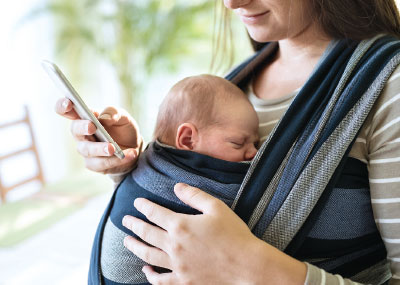Text Messages May Help Educate, Screen New Mothers for PPD
Abstract
Short and direct text communication can be ideal for new mothers, but sending health information by text could cause potential privacy issues.
In the United States, postpartum depression (PPD) is both common and underrecognized. Multiple studies, including a recent analysis from researchers at California’s Chapman University, have calculated that 1 in 8 U.S. women will develop PPD. Groups including the American College of Obstetricians and Gynecologists recommend routine PPD screening of new mothers, but screening is not yet widely implemented.

One obstacle that hinders the broad use of PPD screening is the time and resources it takes to screen pregnant women and new mothers.
Some researchers are exploring whether the use of short text messages between health care professionals and new mothers might be a simple way to screen more women and raise awareness about PPD.
Text messages may seem impersonal for asking sensitive questions about someone’s mental health. But researchers, such as Ariel Dalfen, M.D., who heads the Perinatal Mental Health Program and Perinatal Mental Health Telemedicine Program at Mount Sinai Hospital in Toronto, have found the opposite.
“In our experience, women have been quite welcoming of texts,” she told Psychiatric News. “It can be reassuring to be holding your baby in the middle of the night and receiving a short message that tells you, ‘Someone is thinking of me.’”
A recent study by Dalfen and colleagues from Mount Sinai and the University of Toronto bears this out.
They enrolled 937 new mothers to participate in a 12-week assessment of text-based PPD screening and education. Each week, the women were sent three informational texts designed to bolster depression awareness and self-care. Every two weeks, the women were asked to rate how often they had “little interest or pleasure in doing things” and how often they felt “down, depressed, or hopeless.” Women who screened positive for depressive symptoms based on their responses to the two questions were contacted by telephone and offered an appointment with a perinatal psychiatrist for further screening.
Dalfen and her colleagues found that the text questions were well-received; 99% of the participants answered at least one of the six screening questionnaires, and 67% responded to all six. Almost 80% of the participants recommended using text messages to screen for PPD, and 91% enjoyed receiving the depression awareness and self-care texts.
“Texting is not a revolutionary concept, and studies like this show people will accept and respond to health-based text messages,” said Ian Bennett, M.D., Ph.D., a professor of psychiatry and family medicine at the University of Washington in Seattle. Bennett was not involved with Dalfen’s study but is also interested in the use of digital tools like texts or mobile apps to help keep in touch with vulnerable populations.

Health systems across the country are expanding their online communication efforts, said Bennett, but in most cases health systems are turning to patient portals—secure communication systems where patients can access their health information and correspond with their physician.
While such portals offer security, they lack convenience. Most portals require a patient to take multiple steps to access the information, including registering an email address with the portal, checking email for messages from the portal, and logging into the portal to access these messages. Text messages, by comparison, are delivered quickly and can be replied to quickly.
The trade-off for convenience is reduced privacy. “Texts are not a secure means of communication, which can limit what information can be safely sent,” Bennett said. Additionally, there is the risk of sensitive texts being seen if others access a patient’s phone. Though almost everyone has a smartphone nowadays, there still are many families, particularly those with lower incomes, who share phones.
Matthew Broom, M.D., a pediatrician and vice president of medical affairs at SSM Health Cardinal Glennon Children’s Hospital (affiliated with the University of Saint Louis), thinks that issues with texts’ lack of confidentiality could be overcome. “Privacy is important, but I hope it does not preclude us from moving forward,” he said. Broom has also conducted some research trials with text-based PPD correspondence. A study he conducted a few years back found that sending texts with supportive messaging could boost the effectiveness of PPD counseling among low-income women. Broom believes texts could be a feasible strategy to reach traditionally hard-to-reach populations.
“On the physician end, we need to be careful in how we phrase certain questions,” Broom said. He suggested that health care professionals should consider putting some of the onus onto the end user. Broom noted that some smartphones now have security features, including fingerprint and/or facial recognition technology, which would limit the ability of another person accessing the information over the patient’s cell phone.
The greater challenge Broom sees is not who sees health messages, but how health systems manage these communications. “Who interprets the results, and how are they interpreted?” he asked. Brief text surveys are convenient, but they sacrifice accuracy, he said. For example, the two-question survey used by Dalfen’s team in Toronto did not address suicidal thinking, which is included on the Edinburgh Postnatal Depression Scale (EPDS), a 10-question survey considered the gold-standard for PPD screening.
As Broom explained, a woman could take the EPDS and screen negative overall, but if she scored high on the suicidality question, he would still recommend a follow-up visit.
“And what happens once we identify PPD with a text?” Bennett said. “Can we get a woman who screens positive into the clinic? Is the clinic able to effectively treat additional cases of depression? We cannot put energy into screening tools without putting in equal energy to help women once they have been screened.”
Dalfen agreed that hospitals or clinics that want to embrace mobile screening will likely need to add personnel to track mothers during and after their pregnancy to ensure recurrent messages are sent out in a timely manner. However, since this approach uses an existing technology that many people can access, the costs should not be prohibitive. Multiple studies suggest new mothers are ready and willing for their health care professionals to reach out by text.
Dalfen’s study was published in the February Psychiatric Services in Advance and funded by the Academic Health Science Centre Alternative Funding Program. ■
“Use of Text Messaging for Postpartum Depression Screening and Information Provision” can be accessed here.



